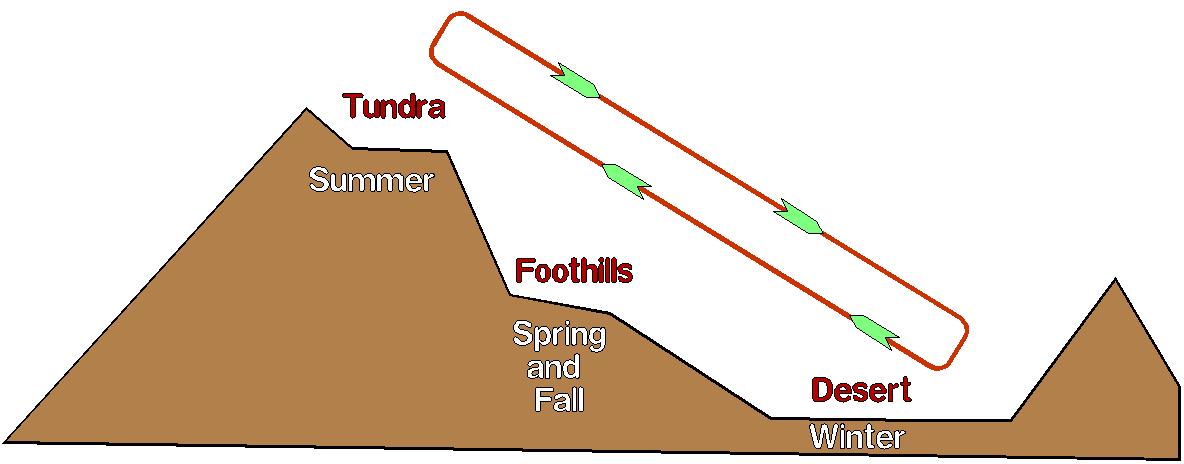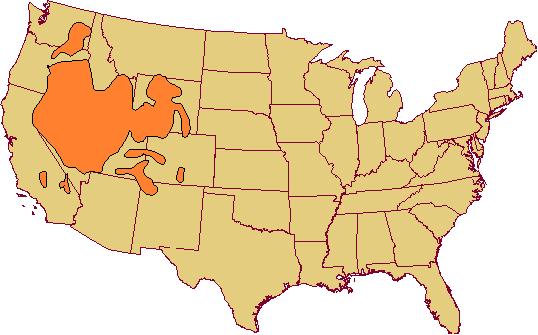

Northern desert shrub is also termed the sagebrush formation, although it is not a desert in the same sense as the southwestern desert shrub because its precipitation is not so low and its temperatures not quite so high. The area is located in southeastern and western Utah, Nevada, north of 37 latitude, southeastern Oregon, southwestern Wyoming, and extending to north central Wyoming including the Big Horn Basin. The region has an area of approximately 60 million hectares, including much of the unallotted public domain that is administered under the Taylor Grazing Act. The region is composed mainly of open, rounded, wide valleys and hilly plateaus ranging in altitude from about 900 meters in the Snake River region in western Idaho to about 2100 meters in parts of the Red Desert in Southwestern Wyoming.
Climate. The region is characterized by low precipitation that comes mainly as snow during the winter. Winter moisture usually penetrates the soil 60 to 120 centimeters, thus favoring growth of shrubs. Average annual precipitation varies from as little as 12 centimeters in the western part of the Great Salt Lake region and parts of western Nevada, and less than 25 centimeters in parts of the Red Desert and Big Horn Basin, to a maximum of about 45 to 50 centimeters in some of the higher valleys in northeastern Utah and southeastern Idaho. The growing season ranges from 90 days to a maximum of 150 days in the Salt Lake and lower Snake River Valleys.
Soils. In the more mesic portions of the northern part where perennial bunchgrasses are common, mollisols occur, while in the Great Basin and Wyoming Basin aridisols dominate with scattered areas of salt and clay accumulations in the profile. Entisols are scattered throughout, particularly in the foot hills regions.
Vegetation. Northern desert shrub range is characterized by widely-spaced shrubs that are deeper rooted than short grasses of the Great Plains. Where the rainfall is 40-60 centimeters, bluebunch wheatgrass, which is more widely spaced than in prairie, becomes important. Since moisture comes mainly during the cool, non-growing period, it penetrates the soil deeply and is utilized by deep-rooted perennials. Plants in the Great Basin are drought resistant, as indeed they must be, to withstand the frequent drouths that may occur at any time. They grow when moisture and temperatures are favorable, and when the moisture is exhausted they become physiologically inactive (dormant) or at least partially so. This phenomenon is more pronounced along the border between this formation and the true desert. Three general vegetation types may be recognized, with the vegetation controlled largely by topography, precipitation, and soil differences (Fig. 3). These three types of cover are fairly well defined but merge or blend into one another, particularly where soil types are not sharply defined. The principal shrubby species are the sagebrushes (Artemesia), shadscale (Atriplex confertifolia), greasewood (Sarcobatus vermiculatus), and winterfat (Eurotia lanata). Important grasses are bluebunch wheatgrass, bottlebrush squirreltail (Sitanion hystrix), indian ricegrass (Oryzopois hymenoides) and bluegrasses.
Management. The major part of the area is used for fall, winter, and spring range, mainly for sheep. Length of the grazing period is determined by climatic conditions and the availability of stock water, which often is obtained by the sheep directly from snow. Sheep are all carefully culled before being moved onto the "desert" to remove the old and weak or sick and those which have poor teeth and which would be likely to die under severe conditions.
The annual movement of sheep on the grazing ranges of the Intermountain region as follows:

The valleys adjacent to the higher mountain ranges where the rainfall exceeds 40 centimeters afford good grazing for farm stock, mainly during summer. These pastures may be made highly productive by irrigation. Where this practice is followed, mixtures of various tame grasses and legumes can be readily established and have high grazing capacities.